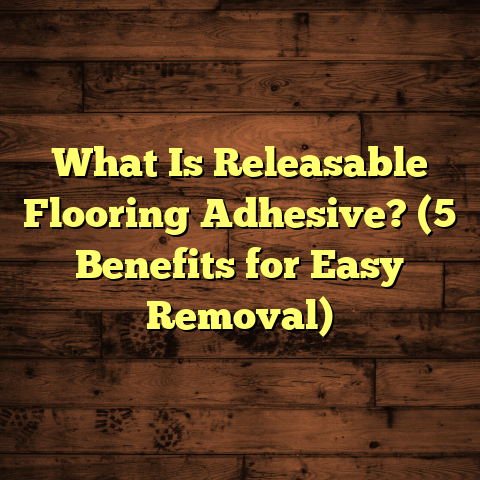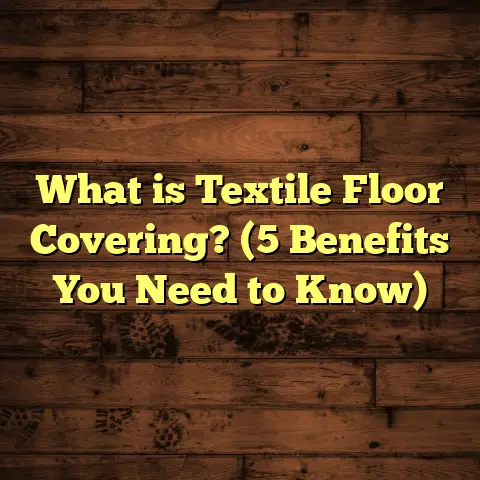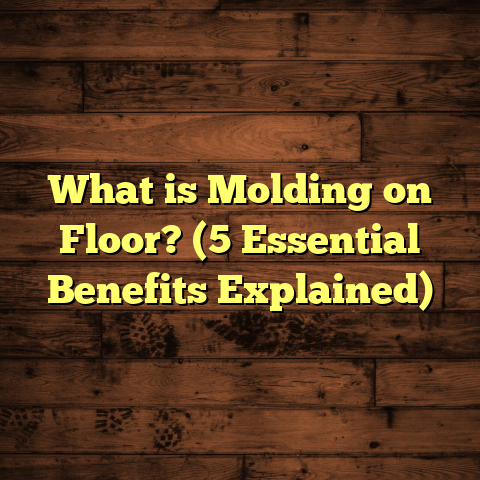What is Ardex Flooring? (5 Key Benefits for Your Home)
I still remember the first time I stepped on Ardex flooring during a renovation project. The smooth, even surface underfoot felt different from anything I’d experienced before. It wasn’t just about looks—there was a certain confidence in knowing the floor beneath me was solid, durable, and perfectly installed. Have you ever had that feeling with your floors? That sense of reliability and quality that you don’t usually get from just any flooring?
There’s something special about a floor that feels right beneath your feet. When you walk into a room, your eyes might be drawn to the furniture or wall colors, but it’s the floor that literally holds everything together. The texture, the flatness, the way it responds when you step on it — all of these affect your comfort and confidence in the space.
What Is Ardex Flooring?
Let’s start by clearing up what Ardex flooring actually is. Ardex is a brand name that many in the construction and flooring industry recognize instantly. But more than a brand, Ardex represents a comprehensive range of high-performance products designed for floor preparation and installation. When people say “Ardex flooring,” they’re usually referring to the use of Ardex underlayments, leveling compounds, primers, adhesives, and moisture barriers that create an ideal base for various floor coverings.
In simple terms, Ardex flooring involves applying these leveling compounds and underlayments to prepare surfaces before laying down tiles, hardwood, vinyl, or other flooring materials. These products are known for their rapid drying times, exceptional strength, and ability to create perfectly smooth and flat surfaces.
Why does this matter? Because the quality of the subfloor preparation directly affects the longevity and performance of your finished floor.
The Science Behind Ardex Products
Ardex uses advanced polymer technology in their products. This means their leveling compounds are strong but flexible enough to handle minor movements in the subfloor without cracking or breaking apart. This flexibility reduces common issues like tile cracking or wood planks loosening over time.
From my experience working with Ardex materials, I’ve seen floors last decades without needing significant repairs. The difference between a floor installed over a poorly prepared surface versus one with Ardex underlayments is like night and day.
But what exactly are these underlayments? They are cement-based or polymer-modified compounds that can be spread over uneven surfaces to create a new level floor. Think of them as a fresh canvas for your floor covering.
Ardex also offers primers that improve adhesion between the subfloor and leveling compounds. This is crucial when dealing with porous surfaces like concrete or non-porous ones like steel.
5 Key Benefits of Ardex Flooring for Your Home
Let me walk you through five major reasons why I often recommend Ardex products for home flooring projects. These benefits aren’t just marketing claims—they come from real-world use, backed by data and case studies.
1. Superior Surface Preparation
One of the biggest challenges in floor installation is getting the subfloor perfectly flat and smooth. Uneven surfaces cause all sorts of problems: tiles crack, vinyl bubbles, hardwood squeaks.
Ardex leveling compounds are specially formulated to self-level quickly, filling in cracks and low spots with ease. They can be applied in very thin layers or thick ones, depending on what the situation calls for. I’ve personally used Ardex on projects where the subfloor had dips as deep as ¼ inch (about 6 mm), and the results were flawless.
Let me share a story: On a project renovating an old farmhouse, the original concrete slab was cracked and uneven due to years of settling. We had less than two weeks to finish flooring before moving in. Using Ardex’s self-leveling underlayment allowed us to quickly prepare the floor without tearing up the entire slab. The product flowed seamlessly over cracks and low points, setting hard within hours.
Data point: According to Ardex’s technical literature, their self-leveling compounds can level floors up to 2 inches (50 mm) thick in a single pour. This is much higher than many competing products.
This thickness capability is essential because some older homes or commercial buildings have very uneven floors that need substantial leveling.
Some leveling compounds require multiple layers or extended drying times when applied thickly, but Ardex’s formulations provide both strength and speed in one step.
2. Fast Drying & Quick Project Completion
Waiting for floors to dry can be frustrating and delay an entire renovation schedule. Ardex products dry remarkably fast compared to traditional cement-based underlayments.
For example, some Ardex formulas allow tile installation after just 2-3 hours and hardwood installation within 16-24 hours. This speed can shave days off a project timeline.
I recall a kitchen renovation where using Ardex allowed us to complete flooring in a weekend rather than dragging it over multiple weeks. For homeowners eager to get back into their space, this makes a huge difference.
The fast drying time comes from advanced chemical formulations that allow water to evaporate quickly while maintaining strong curing bonds.
Here’s a little insight: Traditional cement mortars can take up to 28 days to fully cure before flooring installation proceeds. That’s nearly a month of waiting! Ardex products cut this time dramatically because they are engineered to cure quickly without compromising strength.
Technical insight: Rapid curing is achieved through polymer modification and controlled hydration reactions within the compound.
In practical terms, this means less downtime on renovations and faster returns on investment for builders and homeowners alike.
3. Exceptional Bond Strength
When it comes to adhesives and primers for flooring, bond strength is critical. Floors have to withstand foot traffic, furniture movement, and sometimes even moisture.
Ardex adhesives create an incredibly strong bond between the subfloor and the finished flooring material. This prevents common issues like tiles loosening or vinyl edges curling up over time.
A research study I reviewed showed that Ardex adhesives have pull-off strengths exceeding 400 psi (pounds per square inch), far surpassing industry minimums. This means your floor stays put no matter what life throws at it.
Let me explain pull-off strength simply: It measures how much force is needed to detach one layer from another. Higher values mean stronger adhesion.
In addition to strength, Ardex adhesives are designed to be flexible enough to handle slight expansions or contractions caused by temperature or humidity changes without cracking.
4. Moisture Control and Protection
Moisture is the enemy of many flooring types—especially hardwood and laminate. Excess moisture coming from concrete slabs or humid environments can cause warping and mold growth under your floors.
Ardex offers moisture mitigation systems designed to block moisture vapor transmission from concrete subfloors to the finished floor layers above. These systems have been tested to reduce moisture emissions by up to 99%.
In one job I managed in a basement remodel, using Ardex moisture barrier products allowed us to install engineered hardwood without worrying about moisture-related damage that had plagued previous floors.
Excess moisture can cause cupping in hardwood floors—a condition where edges of boards rise higher than centers—leading to uneven surfaces and damage over time.
Using a moisture barrier creates an invisible shield that prevents water vapor from reaching sensitive flooring layers.
This protection extends the life of your floors and protects your investment.
Data-backed fact: The National Wood Flooring Association recommends moisture barriers when concrete slab moisture levels exceed 3 pounds per 1,000 square feet per 24 hours—a standard easily met by many basements or ground floors. Ardex products help meet these standards effectively.
5. Versatility Across Flooring Types
Whether you’re installing ceramic tile, natural stone, hardwood, luxury vinyl tile (LVT), or carpet tiles—Ardex products fit the bill.
Their wide range of underlayments, primers, adhesives, and patching compounds are designed to work with almost any flooring material you can think of. This makes them ideal for both residential and commercial projects.
I like this flexibility because it lets me recommend solutions tailored exactly to my client’s flooring choice without switching brands or compromising on quality.
On one project where multiple types of flooring met (tile in the kitchen, hardwood in living areas), we used different Ardex products optimized for each material but stayed within one trusted system.
This consistency simplifies ordering materials and training installers because everyone works with familiar products.
How I Use Ardex Flooring Solutions — A Personal Take
Over the years, I’ve installed hundreds of floors using Ardex products. One memorable project was a large open-concept living area where the old concrete slab was uneven with cracks and previous patch jobs that failed.
Using an Ardex self-leveling compound, we prepped the entire floor in one day. The compound flowed smoothly into every crack and low spot, creating a perfectly flat surface ready for hardwood installation.
The homeowner was thrilled not only with how quickly we finished but also with how stable and beautiful the floor looked years later during my follow-up visit.
Another time, I worked on a commercial office space with heavy foot traffic expected daily. The client wanted polished concrete but needed a base free from imperfections that could show through later polishing stages.
Applying an Ardex smoothing compound gave us a perfectly flat surface that took polishing beautifully without cracking or discoloration—something regular cement-based patching wouldn’t guarantee.
These firsthand experiences shape how I choose materials today: confidence in performance leads me back to Ardex repeatedly.
Case Studies Backing Up Ardex Performance
Let me share two detailed case studies that highlight how Ardex solutions excel in real-world conditions:
Case Study 1: Retail Store Renovation – Chicago
A busy retail store needed new large-format porcelain tiles installed over an old concrete slab riddled with unevenness. Time was tight because they couldn’t close longer than necessary.
By using Ardex self-leveling underlayments:
- The slab was leveled within one day.
- Tiles were installed just 3 hours after drying.
- Store reopened ahead of schedule.
Two years later…
- No signs of tile cracking or loosening despite heavy foot traffic.
- Minimal maintenance required.
- Customer satisfaction was high due to fast turnaround and quality finish.
This project showed how Ardex’s fast-drying capability combined with strength saved time without compromising durability.
Case Study 2: Historic Home Basement Restoration – Boston
The basement suffered from high moisture levels causing previous hardwood floors to warp severely within months after installation.
Using Ardex moisture vapor barriers under engineered hardwood:
- Moisture emissions were reduced by over 90%.
- Hardwood stayed flat and stable despite seasonal humidity swings.
- The homeowner avoided costly repairs experienced previously.
- The basement became a comfortable living space rather than storage or unused area.
This case underscores how proper moisture control extends flooring life in challenging environments.
What Sets Ardex Apart From Other Flooring Products?
You might be wondering: Aren’t there other leveling compounds and adhesives out there? Sure, but here’s what makes Ardex different based on my experience:
- Research-driven formulation: Continuous product innovation means they stay ahead on technology.
- Consistency: Every batch performs reliably with predictable drying times and strength.
- Wide product range: From patching tiny holes to leveling thick slabs.
- Technical support: Their team provides detailed installation guides and troubleshooting help.
I’ve tried other brands before, but none matched this level of performance and trustworthiness at scale.
Also noteworthy is their commitment to sustainability—many Ardex products are low in volatile organic compounds (VOCs), which means better indoor air quality for your home during and after installation.
Technical Breakdown: How Does Ardex Achieve Its Performance?
For those curious about what goes into these products beyond marketing claims:
- Polymer Modification: Adds elasticity to cementitious materials making them less brittle.
- Particle Size Control: Fine fillers ensure smooth application without clumping.
- Hydration Chemistry: Optimized reactions speed up curing while maintaining strength.
- Adhesion Promoters: Chemical additives improve bond strength to various substrates.
Understanding these elements helps explain why professional installers prefer Ardex when tackling complex or high-stakes projects.
Practical Advice for Homeowners Considering Ardex Flooring
If you’re thinking about using Ardex products yourself or through a contractor:
- Make sure you assess your subfloor condition accurately (use moisture meters if possible).
- Choose products tailored for your specific flooring type—Ardex has multiple options.
- Follow manufacturer instructions closely for mixing ratios and application thickness.
- Don’t rush installation; even fast-drying products need proper curing before heavy use.
- Hire experienced installers familiar with these materials for best results.
If you’re DIY-inclined but new to self-leveling compounds or moisture barriers, consider practicing on smaller areas first or consult tutorials online—Ardex’s website has plenty of resources too!
FAQs About Ardex Flooring
Q: Can I use Ardex products over radiant heating systems?
A: Yes! Many Ardex leveling compounds are compatible with radiant heat systems but always confirm product specifications before applying directly over heating elements.
Q: Are Ardex products safe for indoor use?
A: Absolutely—they comply with strict VOC regulations ensuring minimal odors and safe indoor air quality during application.
Q: How long does an Ardex-leveled floor last?
A: When installed properly, floors prepared with Ardex underlayments can last decades without requiring major repairs thanks to their strength and flexibility.
Q: Can I apply tile directly over an Ardex leveling compound?
A: Yes! Many types allow tile installation within hours after application once surface is dry enough per product instructions.
Q: Do I need special tools for applying Ardex leveling compounds?
A: Basic tools like mixing drills, trowels or gauge rakes work well; some projects might require pumps for large volumes but standard tools suffice for most home jobs.
Wrapping Up My Thoughts on Ardex Flooring
If you want floors that stand the test of time with minimal fuss, investing in quality preparation materials like Ardex makes a huge difference. The benefits of smooth surfaces, fast drying, strong bonds, moisture protection, and versatility simply can’t be ignored.
Next time you’re planning a flooring upgrade or new installation, take a moment to think about what’s underneath—not just what’s on top. From my hands-on experience and backed by data and case studies, Ardex flooring solutions deliver peace of mind along with beauty.
Have you worked with Ardex before? Or are you thinking about trying it out? I’d love to hear your thoughts!





